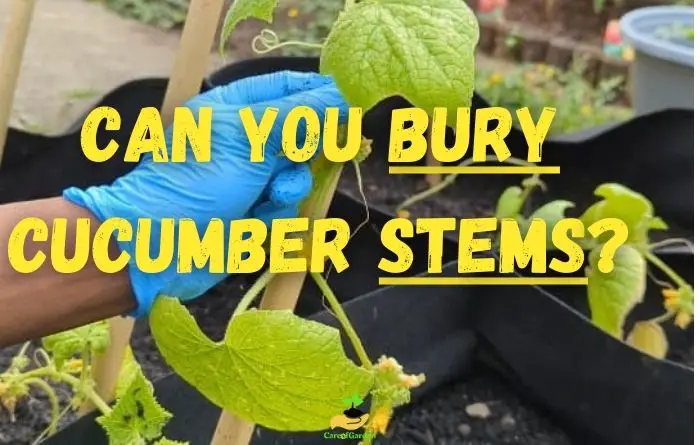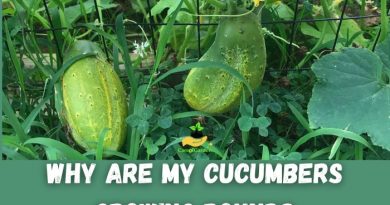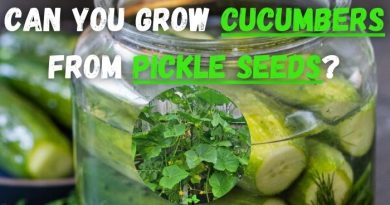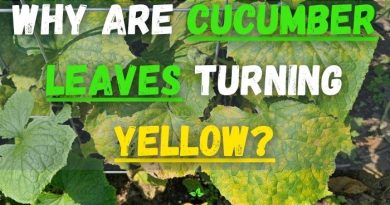Can You Bury Cucumber Stems? Here’s What You Need to Know
As someone who enjoys gardening, I often wondered if burying cucumber stems is a good idea. Through my research and personal experimentation, I’ve discovered that burying cucumber stems can have both advantages and potential drawbacks. So in this blog post, I will show you the benefits and potential risks associated with burying cucumber stems while also offering tips for doing it. So is it advisable to bury cucumber stems?
Yes, you can bury cucumber stems. Burying cucumber stems is a gardening technique that can encourage the development of additional roots along the stem, which can help the plant absorb more nutrients and water, leading to increased growth and yield. However, it’s important to be mindful of the depth of burial and the suitability of the plant for this technique.
Can you bury cucumber stems?
Based on my research and personal gardening experience, I’ve discovered that burying cucumber stems can actually have some advantages and a few disadvantages. When you bury the cucumber stem it develops additional roots that aid in the absorption of nutrients and water by the plant. Moreover, burying the stem also offers added stability to prevent your cucumber plant from falling over or breaking in strong winds.
A recent research article, in BMC Plant Biology (source: BMC Plant Biology) revealed that cucumbers and other plants, from the same family possess biomass in their stems and petioles making them valuable contributors to photosynthesis. Moreover burying the stem of a cucumber plant can stimulate the growth of new roots, facilitating absorption of nutrients and water from the soil.
At first glance, the notion of burying cucumber stems may appear to contradict gardening wisdom. Typically it is advised to keep the stems above ground, as they act as channels, for nutrients and water. Nevertheless, a technique called stem burying or trenching has gained the interest of gardeners who argue that it can improve the well-being and productivity of cucumber plants.
Proponents of burying cucumber stems argue that this technique mimics natural processes that occur in the wild. In nature, fallen leaves and plant debris decompose and enrich the soil with nutrients, creating a fertile environment for nearby plants.
Stem burying essentially attempts to replicate this process by allowing cucumber stems to break down directly in the soil. This, in turn, could potentially lead to better overall plant health and higher yields of cucumbers.
However, as always when we try a new gardening method, there are potential risks associated with burying cucumber stems, such as cracking or breaking the stem, creating a moist environment for fungi and other pathogens, and creating a hiding place for pests like slugs and snails.
Before embracing this technique, I advise you to experiment in a small section of your garden.
Benefits of Burying Cucumber Stems
Burying cucumber stems can have several benefits:
1. Enhanced Root Development
Burying cucumber stems creates an opportunity for secondary rooting. Nodes along the stem have the remarkable ability to develop roots when in contact with soil. This results in a denser and more expansive root system, enabling your cucumber plants to better explore and absorb nutrients and water from the surrounding soil.
2. Increased Nutrient Uptake
With additional root growth facilitated by buried stems, cucumber plants can tap into a wider array of nutrients present in the soil. This heightened nutrient uptake can contribute to healthier foliage, more robust vines, and ultimately, a potentially higher yield of cucumbers.
3. Improved Plant Stability
The secondary roots that emerge from buried cucumber stems provide additional anchorage for the plant. This added stability becomes especially valuable as your cucumber plants grow larger and produce more fruits. Enhanced structural support helps prevent the plants from toppling over under its own weight.
4. Boost Yield
It’s a botanical equation: healthy stems + vigorous roots = abundant harvest. By embracing stem burial, you’re fostering a robust stem-root system, a foundation for prolific fruiting.
The practice nurtures the optimal conditions necessary for cucumber plants to channel their energy into flowering and fruit development. Witness your garden flourish with a higher yield, a direct result of your plants’ enhanced growth architecture.
5. Resilience to Environmental Stress
The reinforced root system resulting from buried cucumber stems can enhance the plant’s ability to withstand environmental stressors. This includes factors like drought, fluctuating temperatures, and nutrient deficiencies. The bolstered root network acts as a resilient foundation that aids the plant in adapting to varying conditions.
Potential Risks Burying Cucumber Stems and How to Avoid Them
While burying cucumber stems can have benefits, there are also potential risks:
1. Disease Susceptibility
When burying cucumber stems, it’s important to be aware that there can be consequences, in terms of disease susceptibility.
The moisture trapped around buried stems can create an environment for fungal growth and rot. To minimize this risk make sure to maintain good spacing between cucumber plants. Also, try choosing cucumber varieties that are resistant to diseases.
2. Stem Damage
When burying cucumber stems it’s crucial to handle them to avoid causing damage. Take care while tucking the stems into the soil, using a gentle touch to prevent any unintentional harm.
Also, I advise you to carry out this process in the morning to minimize stress on the plants.
How to Bury Cucumber Stems
Burying the stems of cucumbers is a gardening method that certain gardening enthusiasts believe can have effects, on the overall health and productivity of the plants.
Although not everyone agrees with this technique if you’re interested in giving it a try here’s a step, by step guide to help you effectively bury the cucumber stems:
Step 1: Choose Suitable Cucumber Varieties
Opt for cucumber varieties that are more resilient and adaptable to experimental techniques like stem burying. Research and select cucumber types that have a higher chance of success in your specific climate and growing conditions.
Step 2: Prepare the Soil
Before you bury the stems of the cucumbers make sure that the soil, in your garden has drainage and is well aerated. Loosen up the soil in the area where you want to bury them so that it creates an environment, for decomposition.
Step 3: Select Healthy Stems
Choose cucumber stems that are healthy and disease-free. Avoid stems that show signs of damage, disease, or stress.
Step 4: Prune the Stems
If necessary, prune the cucumber stems to a manageable length. Aim for stems that are approximately 4 to 6 inches long.
Step 5: Dig Trenches
Using a shovel or garden fork, dig shallow trenches in the soil where you intend to bury the cucumber stems. The trenches should be about 2 to 3 inches deep.
Step 6: Bury the Cucumber Stems
Gently place the pruned cucumber stems in the trenches. Ensure that the stems are positioned horizontally and not vertically. Spacing between stems should allow for proper airflow and decomposition.
Step 7: Cover with Soil
Carefully cover the cucumber stems with soil, ensuring that they are completely buried. Press the soil down gently to secure the stems in place.
Step 8: Water Thoroughly
After burying the cucumber stems, water the area thoroughly to help settle the soil and initiate the decomposition process.
Step 9: Monitor and Maintain
Regularly monitor the buried cucumber stems for any signs of distress, disease, or improper decomposition. Make adjustments as needed to ensure the stems are breaking down without causing harm to the plant.
Step 10: Evaluate Results
Observe the overall health and growth of your cucumber plants over time. Compare the growth and productivity of plants with buried stems to those without to assess the effectiveness of the technique in your specific garden.
Step 11: Adjust and Refine
Based on your observations and results, refine your approach if you plan to continue burying cucumber stems in the future. Consider experimenting with different cucumber varieties, burial depths, and soil conditions to optimize your results.
How deep should I bury my cucumber stems?
| Growth Stage | Recommended Planting Depth for Burying Stems |
|---|---|
| Seedling Stage | 1-2 inches (2.5-5 cm) below the cotyledons |
| Young Plant Stage | 3-4 inches (7.5-10 cm) below the first true leaves |
| Established Plant | 5-6 inches (12.5-15 cm) below the third to fourth true leaves |
https://careofgarden.com/cucumber-growth-stages/
Can you bury cucumber stems when transplanting?
Yes, you can bury cucumber stems when transplanting. Burying cucumber stems is a gardening technique that can encourage the development of additional roots along the stem, which can help the plant absorb more nutrients and water, leading to increased growth and yield.
However, it’s crucial to keep things in mind. Off make sure you don’t bury the stems deep or too shallow; finding the right depth is key. Additionally, not all cucumber plants are suitable for this technique so be mindful of that well.
Lastly, there are risks involved with burying cucumber stems. These include the possibility of damaging or breaking the stem during burial creating an environment that may attract fungi and other pathogens and providing a hiding spot for pests like slugs and snails.
So while burying cucumber stems can be beneficial if done correctly and, with caution just remember to weigh these factors before giving it a go!
Conclusion
In conclusion, burying cucumber stems can have both benefits and potential risks. It is important to bury the stem up to the first set of leaves and use clean potting soil or sterilized soil to avoid suffocation and the introduction of pathogens. With proper care, burying cucumber stems can be a helpful technique for promoting plant health and preventing rot.




